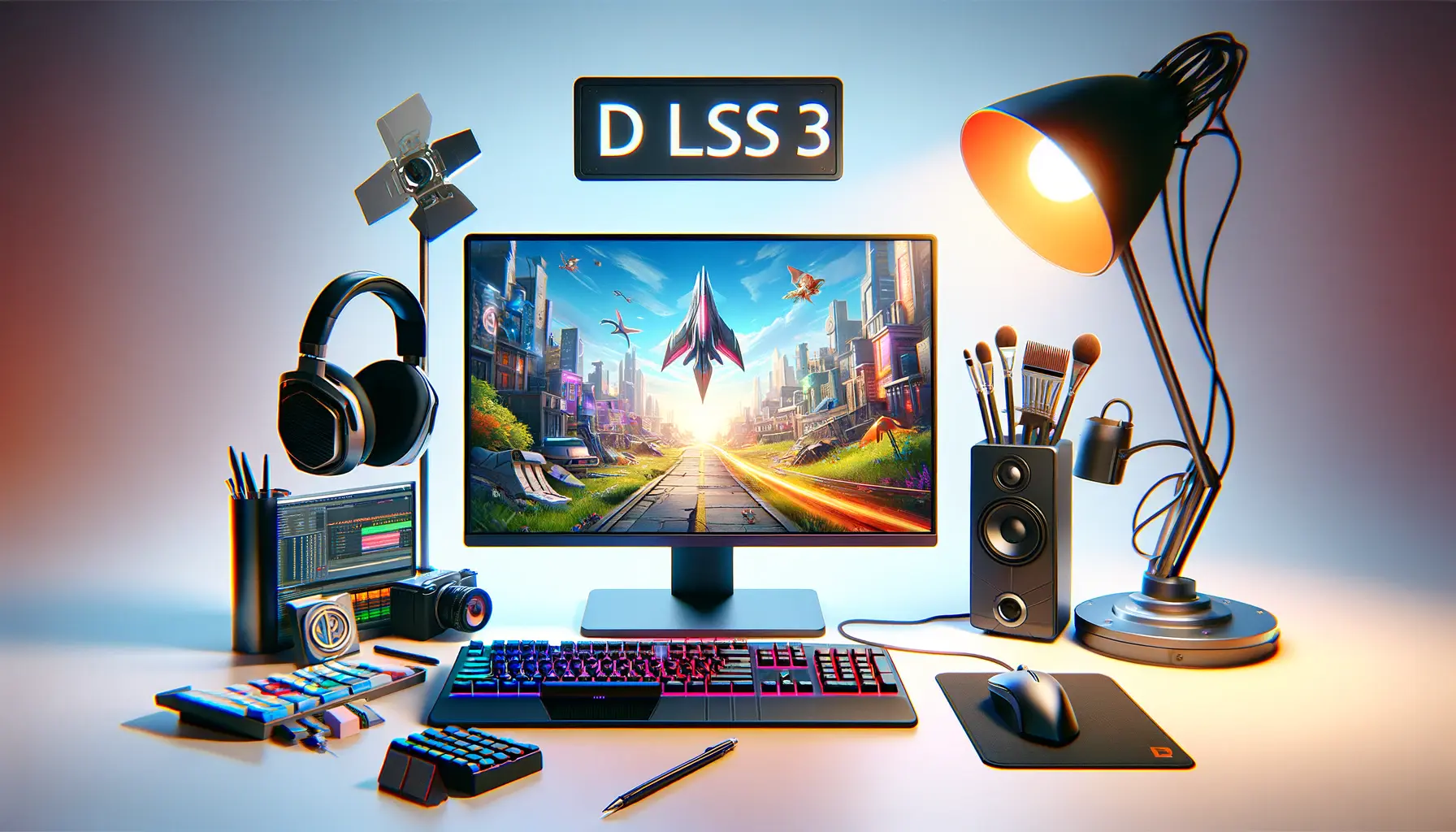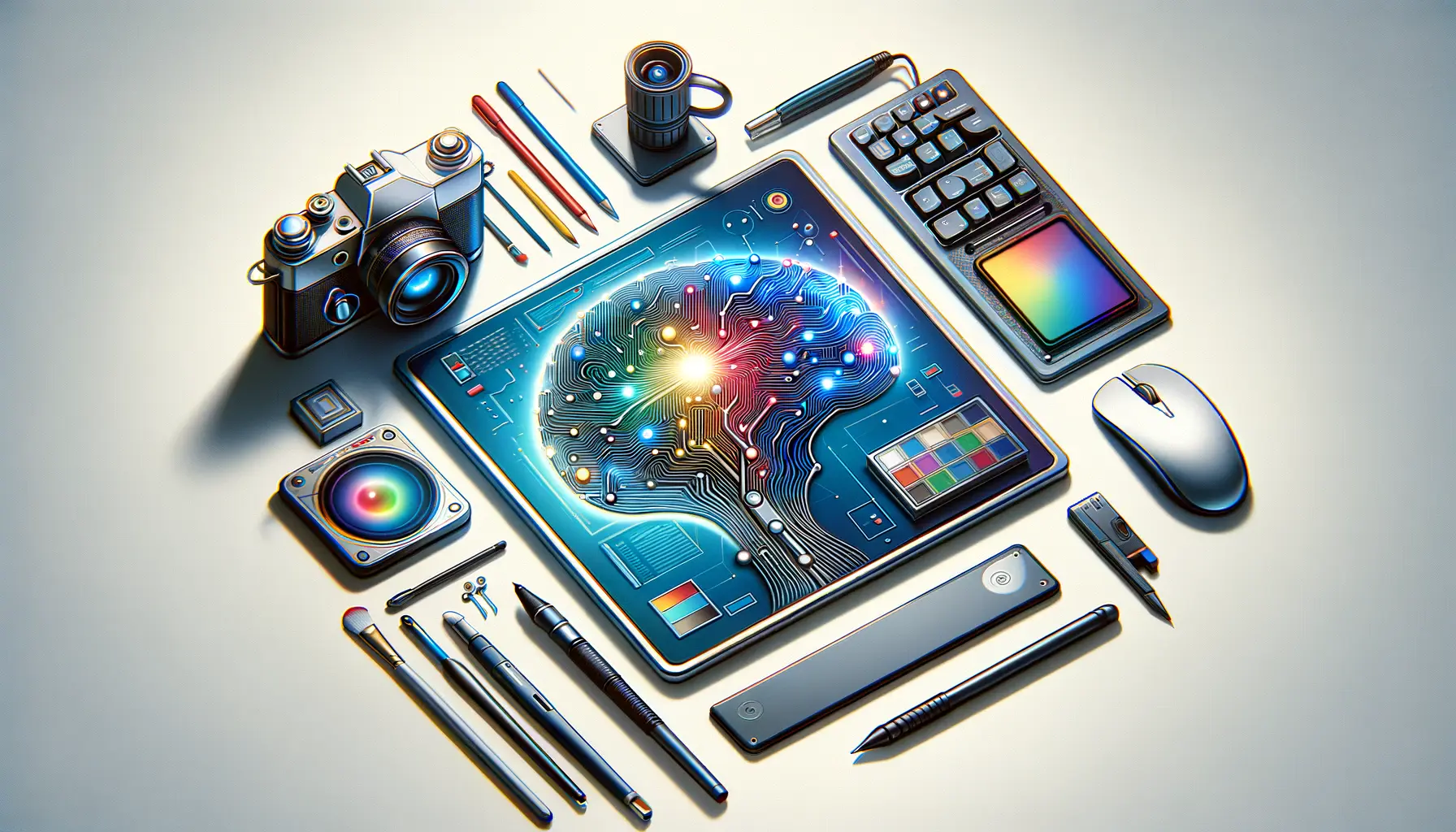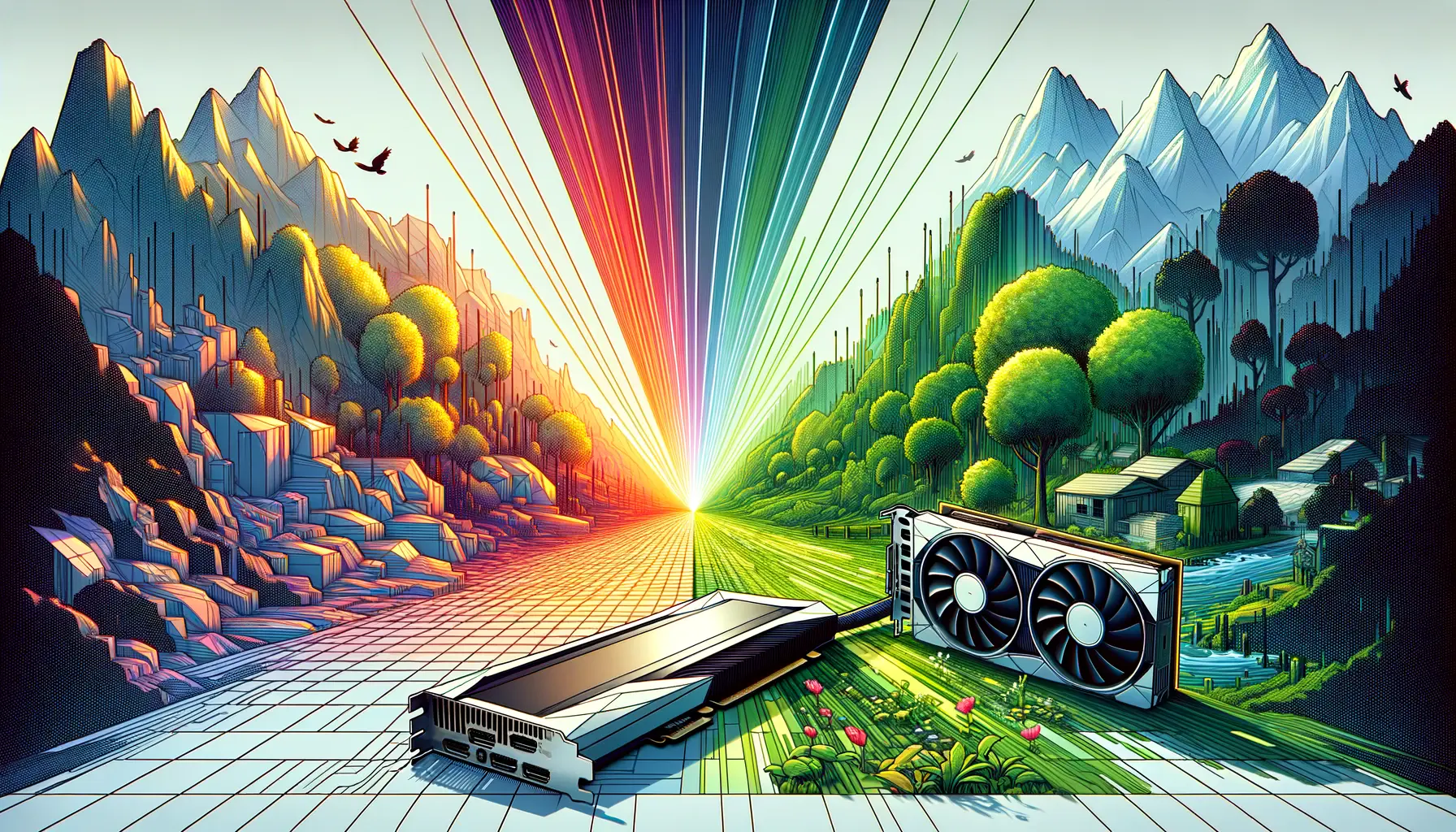The advent of NVIDIA’s DLSS 3 technology marks a significant leap forward in the realm of digital content creation, particularly for those who harness the power of video and graphics to tell stories, convey messages, or showcase products.
Deep Learning Super Sampling (DLSS) 3, developed by NVIDIA, is not just a tool for gamers seeking higher frame rates without compromising on visual fidelity; it’s a groundbreaking innovation that content creators across various industries can leverage to enhance their workflows, improve output quality, and unlock new creative possibilities.
At its core, DLSS 3 utilizes advanced AI and machine learning algorithms to upscale images in real-time, allowing for smoother performance and higher quality visuals on supported NVIDIA RTX graphics cards.
This technology is particularly beneficial for content creators who work with 3D rendering, video editing, and other graphics-intensive applications.
By significantly reducing rendering times while maintaining, or even improving, image quality, DLSS 3 enables creators to iterate more rapidly and spend more time on the creative aspects of their projects.
- Exploring the Impact of DLSS 3 on Content Creation
- DLSS 3’s Role in Enhancing Image Quality
- Streamlining Content Production with DLSS 3
- DLSS 3 and the Future of Interactive Media
- Overcoming Challenges in High-Resolution Content Creation
- DLSS 3’s Influence on Gaming and Simulation
- Maximizing Creative Output with DLSS 3
- Embracing the Future with DLSS 3
- DLSS 3 for Content Creators: FAQs
Exploring the Impact of DLSS 3 on Content Creation
Enhanced Efficiency in Workflow
The integration of DLSS 3 into a content creator’s workflow brings about a paradigm shift in how projects are approached and executed.
By offloading some of the most computationally intensive tasks to AI, creators can benefit from reduced rendering times.
This efficiency gain is not just about speed; it’s about the ability to produce higher quality content within the same time frames.
For instance, rendering a complex 3D scene that would traditionally take hours can be completed in a fraction of the time, without sacrificing detail or texture quality.
Moreover, this efficiency extends beyond rendering to include real-time editing and previewing.
Content creators working on video projects can experience smoother playback and faster editing, even when dealing with 4K or 8K footage.
This immediate feedback loop allows for quicker adjustments and experimentation, fostering a more creative and less constrained working environment.
Unlocking Creative Potential
DLSS 3 not only optimizes existing workflows but also opens the door to new creative possibilities.
With the barriers of long rendering times and suboptimal performance removed, creators can explore more complex and visually demanding projects.
This could mean more intricate 3D models, higher resolution textures, or more sophisticated visual effects in videos.
The ability to work more freely with these elements can lead to more innovative and visually stunning creations that stand out in a crowded content landscape.
Additionally, the improved performance and efficiency provided by DLSS 3 can democratize high-quality content creation.
Smaller studios and independent creators, who may not have access to large render farms or extensive hardware resources, can produce work that competes with larger entities.
This leveling of the playing field is crucial for fostering diversity and innovation in the creative industries.
DLSS 3’s impact on content creation extends beyond mere technical improvements; it empowers creators with more freedom, efficiency, and potential for innovation, setting a new standard for what’s possible in digital storytelling and visual content.
DLSS 3’s Role in Enhancing Image Quality
The hallmark of DLSS 3 technology lies in its unparalleled ability to enhance image quality while simultaneously boosting performance.
This dual benefit is particularly crucial for content creators who strive for visual excellence without compromising on efficiency.
DLSS 3 achieves this by employing a unique combination of frame generation and AI-driven super-resolution techniques, which together ensure that every pixel on the screen is optimized for the highest quality.
Understanding how DLSS 3 enhances image quality requires a dive into its two core components:
- AI Super Resolution: This technique uses deep learning algorithms to intelligently upscale lower-resolution images to higher resolutions. By analyzing thousands of images, DLSS 3 learns how to predict and generate high-quality images from lower-quality inputs, resulting in crisp, clear visuals that rival native high-resolution rendering.
- Frame Generation: DLSS 3 introduces an innovative frame generation process that creates additional frames between existing ones. This not only smooths out motion and reduces blur in fast-moving scenes but also contributes to a more stable and visually appealing output. For content creators, this means smoother animations and more dynamic presentations, enhancing the viewer’s experience.
Real-World Applications for Improved Visuals
In practical terms, the image quality improvements offered by DLSS 3 can be transformative for various types of content creation.
For video producers, the ability to maintain high resolution and detail in fast-paced scenes ensures that every frame conveys the intended message or emotion without degradation.
Graphic designers and 3D artists, on the other hand, can achieve more realistic textures and lighting effects, making their creations more lifelike and immersive.
Moreover, the benefits of DLSS 3 extend to live streaming and broadcasting.
Streamers can deliver higher quality content to their viewers, even when broadcasting demanding games or applications.
This improvement in stream quality can significantly enhance viewer engagement and satisfaction, crucial factors for success in the competitive streaming space.
The advancements in image quality brought about by DLSS 3 are not just technical feats; they are tools that empower creators to push the boundaries of visual storytelling, ensuring that their content is as impactful and engaging as possible.
Streamlining Content Production with DLSS 3
The introduction of DLSS 3 into the content creation process represents a significant leap towards streamlining production workflows.
This technology not only enhances the visual quality of the content but also simplifies the production process, allowing creators to focus more on creativity and less on overcoming technical limitations.
The impact of DLSS 3 on streamlining content production can be observed in several key areas:
Firstly, the reduction in rendering times is a game-changer for professionals working with 3D animation and visual effects.
By leveraging the AI-driven capabilities of DLSS 3, creators can render scenes much faster than traditional methods, without sacrificing quality.
This efficiency boost is particularly valuable in industries where time is of the essence, such as advertising and film production.
- Real-Time Previewing: DLSS 3 enables content creators to preview their work in real-time with full resolution and effects applied. This immediate feedback allows for rapid iteration and experimentation, significantly speeding up the creative process.
- Enhanced Collaboration: Faster rendering and real-time previewing capabilities make it easier for teams to collaborate on projects. Changes can be made and reviewed quickly, facilitating a more dynamic and responsive creative environment.
- Accessibility to High-Quality Production: DLSS 3 democratizes access to high-quality content production, enabling smaller studios and independent creators to produce work that rivals that of larger, more resource-rich organizations. This accessibility fosters innovation and diversity in content creation across various media.
Case Study: Accelerating Animation Production
A notable example of DLSS 3’s impact on streamlining content production is its use in animation studios.
In one case, a studio working on a feature-length animated film was able to reduce their rendering times by over 50% by integrating DLSS 3 into their pipeline.
This reduction allowed the studio to allocate more resources to artistic development and narrative refinement, significantly enhancing the overall quality of the film.
The ability to render high-quality animations quickly also enabled the studio to meet tight deadlines without compromising on the visual integrity of their work.
The benefits of DLSS 3 in streamlining content production extend beyond individual projects.
By reducing the time and resources required for high-quality content creation, DLSS 3 allows creators and studios to take on more projects simultaneously, increasing productivity and potential revenue.
This efficiency gain is transforming the content creation landscape, making it more dynamic, competitive, and innovative.
Embracing DLSS 3 technology in content production workflows represents a forward-thinking approach, enabling creators to leverage the latest advancements in AI and machine learning to produce stunning visuals more efficiently than ever before.
DLSS 3 and the Future of Interactive Media
The integration of DLSS 3 technology is not just revolutionizing current content creation workflows; it’s also shaping the future of interactive media.
As we stand on the brink of new digital experiences, including virtual reality (VR), augmented reality (AR), and mixed reality (MR), the role of DLSS 3 in enhancing and facilitating these experiences cannot be overstated.
The technology’s ability to deliver high-quality visuals at unprecedented speeds is pivotal for the immersive and responsive environments that define interactive media.
Interactive media demands a level of visual fidelity and performance that can challenge even the most advanced systems.
DLSS 3 addresses these challenges head-on, enabling creators to build more detailed and complex virtual worlds without the limitations imposed by hardware constraints.
This capability is crucial for developing VR and AR experiences, where the immersion factor is heavily dependent on the quality and fluidity of the visual output.
- Enhancing VR and AR Experiences: DLSS 3’s efficient upscaling and frame generation techniques significantly improve the visual quality in VR and AR applications, making virtual environments more realistic and engaging. This enhancement is vital for applications ranging from entertainment to education and training simulations.
- Facilitating Real-Time Interactivity: The technology’s ability to maintain high performance under demanding conditions makes it ideal for interactive media, where real-time user input and environmental changes are constant. DLSS 3 ensures that these experiences remain smooth and responsive, even as the complexity of the virtual world increases.
- Empowering Creators: By lowering the technical barriers to high-quality content production, DLSS 3 empowers creators to explore the full potential of interactive media. Developers can experiment with more ambitious projects, pushing the boundaries of what’s possible in virtual storytelling and interactive experiences.
Case Study: Transforming Educational Content
A compelling application of DLSS 3 in interactive media is its use in educational VR experiences.
One project involved creating a virtual historical site tour, allowing students to explore ancient civilizations in a highly detailed and interactive 3D environment.
DLSS 3 played a crucial role in this project by enabling the developers to render the complex scenes in real-time, ensuring that the virtual tour was both visually stunning and educationally engaging.
The technology’s ability to deliver high-quality visuals at fast speeds made it possible to include intricate details and animations that brought the historical site to life, enhancing the educational value of the experience.
The impact of DLSS 3 on the future of interactive media is profound.
As we continue to explore the possibilities of VR, AR, and beyond, the technology’s contribution to creating more immersive, detailed, and interactive experiences will be invaluable.
It not only enhances the quality of these experiences but also makes them more accessible to creators and audiences alike.
DLSS 3 is setting the stage for a new era of interactive media, where the limitations of the past give way to a future full of rich, immersive, and engaging digital experiences.
Overcoming Challenges in High-Resolution Content Creation
High-resolution content creation poses significant challenges for creators, ranging from hardware limitations to increased production times.
DLSS 3 technology emerges as a critical solution to these challenges, enabling creators to produce high-resolution content more efficiently and with greater ease.
This section explores how DLSS 3 addresses the common hurdles faced in high-resolution content creation and the implications for creators across various fields.
One of the primary challenges in creating high-resolution content is the demand it places on computing resources.
High-resolution videos, images, and 3D models require significant processing power for rendering, which can slow down production and increase costs.
DLSS 3 mitigates this issue by utilizing AI to intelligently upscale content, reducing the strain on hardware without compromising on quality.
This approach allows creators to achieve their desired resolution and visual fidelity without needing top-tier hardware.
- Reducing Rendering Times: By upscaling lower-resolution inputs to higher-quality outputs, DLSS 3 significantly cuts down rendering times. This efficiency is particularly beneficial for projects with tight deadlines or for creators who need to iterate quickly.
- Improving Performance on Limited Hardware: DLSS 3 enables creators to produce high-resolution content on less powerful systems. This accessibility opens up high-quality content creation to a broader range of creators, including those with limited budgets for hardware upgrades.
- Enhancing Visual Quality: Beyond efficiency and performance, DLSS 3 also improves the visual quality of high-resolution content. The AI-driven process ensures that the upscaled content retains detail and clarity, making it indistinguishable from natively high-resolution material.
Case Study: Independent Filmmaking
An illustrative example of DLSS 3’s impact can be seen in the world of independent filmmaking.
An independent filmmaker was able to produce a short film in 4K resolution on a modest budget, thanks to DLSS 3.
The technology allowed for the film to be shot and edited in lower resolutions and then upscaled to 4K without losing visual quality.
This process not only saved on production costs but also enabled the filmmaker to distribute the film in high resolution, meeting the expectations of modern audiences and film festivals.
The role of DLSS 3 in overcoming the challenges of high-resolution content creation is transformative.
By providing a solution that balances performance, quality, and accessibility, DLSS 3 is enabling a new wave of high-resolution content that is both beautiful and attainable.
As the demand for high-quality digital content continues to grow, technologies like DLSS 3 will play a pivotal role in meeting these expectations efficiently and creatively.
DLSS 3 is revolutionizing the way we approach high-resolution content creation, breaking down barriers and setting new standards for quality and efficiency in the digital age.
DLSS 3’s Influence on Gaming and Simulation
The influence of DLSS 3 technology extends far beyond traditional content creation, making a significant impact on the gaming and simulation industries.
In these fields, the balance between visual fidelity and performance is crucial, not just for the sake of aesthetics but also for ensuring a seamless and immersive user experience.
DLSS 3 addresses this balance head-on, offering solutions that enhance both the visual quality and the performance of games and simulations.
Gaming, in particular, benefits from DLSS 3’s ability to deliver higher frame rates without compromising on graphic details.
This improvement allows gamers to experience their favorite titles in stunning clarity and smoothness, even on mid-range hardware.
Similarly, simulations, which are often used for training and educational purposes, can achieve a level of realism and responsiveness that was previously difficult to attain.
The implications of DLSS 3 in these areas are profound, affecting not only the development process but also the end-user experience.
- Boosting Frame Rates in Gaming: DLSS 3 enables games to run at higher frame rates by intelligently generating frames and upscaling from lower resolutions. This process ensures that games look better and play smoother, enhancing the overall gaming experience.
- Enhancing Realism in Simulations: For simulations, the improved visual quality and performance contribute to more realistic and effective training environments. Whether for military training, medical simulations, or educational tools, DLSS 3 helps create environments that closely mimic real-world conditions.
- Accessibility and Inclusivity: By allowing games and simulations to run smoothly on a wider range of hardware, DLSS 3 makes these experiences more accessible to a broader audience. This inclusivity is crucial for both entertainment and educational applications, ensuring that more individuals can benefit from these advanced digital experiences.
Case Study: Enhancing Flight Simulation
A notable application of DLSS 3 in the simulation industry is its use in flight simulators.
A development team working on a next-generation flight simulator integrated DLSS 3 to achieve unparalleled levels of detail and performance.
The technology allowed for realistic rendering of landscapes, weather conditions, and aircraft models, all while maintaining high frame rates crucial for simulating the experience of flight accurately.
This integration not only improved the visual quality and realism of the simulator but also made it more accessible to users with varying levels of hardware, broadening its educational and recreational appeal.
The influence of DLSS 3 on gaming and simulation underscores the technology’s versatility and its potential to redefine user experiences across a wide range of interactive media.
As developers continue to explore and implement DLSS 3, we can expect to see even more innovative applications that push the boundaries of what’s possible in digital entertainment and training.
The misconception that DLSS 3 is only beneficial for high-end gaming PCs is debunked by its widespread application across various hardware, proving its value in enhancing accessibility and performance for all users.
Maximizing Creative Output with DLSS 3
In the evolving landscape of digital content creation, DLSS 3 stands out as a transformative tool that significantly enhances the capabilities of creators across various disciplines.
By harnessing the power of AI to improve both efficiency and quality, DLSS 3 enables creators to maximize their creative output like never before.
This final section explores the overarching benefits of DLSS 3 for content creators, highlighting how it facilitates a more creative, efficient, and innovative production process.
The essence of DLSS 3’s impact lies in its ability to break down the technical barriers that have traditionally limited creative expression.
Whether it’s through reducing rendering times, enhancing image quality, or enabling more complex and detailed projects, DLSS 3 provides creators with the freedom to explore new ideas and push the boundaries of their work.
This liberation from technical constraints opens up a world of possibilities for storytelling, visual effects, and interactive experiences.
- Empowering Small Teams and Independent Creators: DLSS 3 levels the playing field, allowing small teams and independent creators to produce content that rivals the output of larger studios. This empowerment leads to a more diverse and vibrant creative landscape, enriched by a wider range of voices and perspectives.
- Facilitating Rapid Iteration and Experimentation: The efficiency gains afforded by DLSS 3 enable creators to iterate and experiment at a much faster pace. This rapid prototyping is crucial for innovation, allowing creators to explore multiple ideas and refine their work in real-time.
- Enhancing Visual Storytelling: With DLSS 3, creators can achieve a higher level of visual fidelity, bringing their stories and concepts to life with stunning detail and clarity. This enhancement in visual storytelling captivates audiences, making content more engaging and impactful.
Case Study: Revolutionizing Indie Game Development
An inspiring example of DLSS 3’s impact can be seen in the indie game development scene.
An indie game studio utilized DLSS 3 to develop a visually stunning and immersive game that could run smoothly on a wide range of hardware.
The technology enabled the studio to include high-quality textures, complex lighting effects, and smooth gameplay mechanics without the need for a high-end gaming rig.
This approach not only enhanced the gaming experience but also significantly broadened the game’s potential audience.
The success of this project highlights DLSS 3’s role in enabling creative visions to come to fruition, regardless of hardware limitations.
As we look to the future, the role of DLSS 3 in maximizing creative output is clear.
Its ability to enhance both the quality and efficiency of content creation processes represents a major leap forward for creators.
By continuing to leverage DLSS 3, the creative industry can expect to see a new era of innovation, diversity, and excellence in digital content.
The adoption of DLSS 3 technology is a testament to the creative industry’s ongoing quest for innovation, offering a glimpse into the future of digital content creation where quality and efficiency coexist harmoniously.
Embracing the Future with DLSS 3
In the realm of digital content creation, the advent of NVIDIA’s DLSS 3 technology represents a pivotal shift towards more efficient, high-quality production processes.
This article has explored the myriad ways in which DLSS 3 benefits content creators, from enhancing image quality and streamlining workflows to democratizing high-resolution content creation and shaping the future of interactive media.
As we’ve seen, DLSS 3 is not merely a technological advancement; it’s a tool that empowers creators to push the boundaries of what’s possible, fostering innovation and creativity across various sectors.
Key Takeaways for Content Creators
The journey through the capabilities and impacts of DLSS 3 reveals several key takeaways for content creators:
- DLSS 3 significantly reduces rendering times, enabling faster production cycles and more time for creative exploration.
- The technology’s AI-driven upscaling offers unmatched image quality, making high-resolution content more accessible and feasible.
- By improving performance on a wide range of hardware, DLSS 3 ensures that cutting-edge content creation is not limited to those with high-end setups.
- Its influence extends beyond traditional content creation, enhancing gaming, simulations, and interactive media with higher frame rates and better visuals.
- DLSS 3 levels the playing field for creators, allowing small teams and independents to produce content that stands shoulder to shoulder with that of larger studios.
Looking Ahead: The Role of DLSS 3 in Future Content Creation
As digital technologies continue to evolve, the role of DLSS 3 in content creation is expected to grow and diversify.
The technology’s potential to transform creative workflows and output quality is just beginning to be realized.
Looking ahead, we can anticipate several developments:
- Broader adoption across industries, as more creators recognize the benefits of DLSS 3 for their projects.
- Continuous improvements and updates from NVIDIA, further enhancing the technology’s capabilities and applications.
- Increased integration into educational and training simulations, where realism and performance are paramount.
- Expansion into new areas of content creation, including virtual production and real-time broadcasting, where DLSS 3’s efficiency and quality enhancements can provide significant advantages.
In conclusion, DLSS 3 stands as a testament to the power of AI in revolutionizing content creation.
By offering a blend of efficiency, quality, and accessibility, it provides content creators with the tools they need to realize their visions without compromise.
As we move forward, the continued evolution and adoption of DLSS 3 will undoubtedly play a critical role in shaping the future of digital content, making it an exciting time for creators and audiences alike.
DLSS 3 for Content Creators: FAQs
Explore commonly asked questions about DLSS 3 and its impact on content creation.
DLSS 3 combines AI-driven super resolution and frame generation, leveraging NVIDIA’s latest Tensor Cores and Optical Flow Accelerator for enhanced performance and image quality.
Yes, DLSS 3 can significantly enhance video editing by reducing rendering times and improving playback smoothness, especially in high-resolution projects.
Absolutely, DLSS 3 levels the playing field, allowing smaller teams to produce high-quality content efficiently, without needing high-end hardware.
For gaming content creators, DLSS 3 ensures smoother gameplay and higher quality visuals, making game streams and recordings more engaging.
DLSS 3 is designed for the latest NVIDIA RTX GPUs, leveraging their advanced architecture for optimal performance and image quality.
Yes, DLSS 3 enhances live streaming by improving video quality and performance, enabling creators to deliver smoother and clearer content.
DLSS 3 introduces frame generation technology, offering significant improvements over previous versions in both performance and image quality.
DLSS 3 enhances VR content creation by providing higher frame rates and better image quality, crucial for immersive virtual reality experiences.










